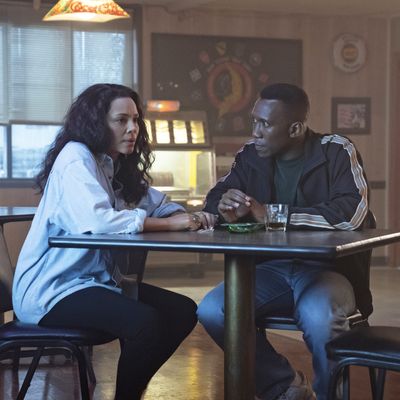
Midway through the penultimate episode of True Detective’s third season, former major crimes detective Wayne Hays (Mahershala Ali) and documentarian Elisa Montgomery (Sarah Gadon) stage their final sit-down interview for True Criminal, her investigation into the decades-old Purcell abduction and murder. Montgomery is feeling herself. She’s got archival newspaper clips cued up, along with Google results about coded criminal symbology and theories about powerful men getting between good cops like Hays and conclusive justice.
In essence, Montgomery believes she’s cracked the case of Julie Purcell’s disappearance back in 1980. She links the missing girl to a rash of organized kidnapping and sex-trafficking operations around the region, including the Yellow King case that True Detective tackled in season one. Her posture alters. She leans into Hays, eager for him to validate her reportorial instincts, asking, “You saw nothing that suggested obfuscation from higher quarters?” She doesn’t know it, but their time together is done. Despite his creeping dementia, Hays has been stringing his young counterpart along for weeks, teasing out information that might lead him closer to closure in a matter that dogged and defined his marriage, closest friendships, relationships with his kids, and once-promising career. In response, he offers what she soon realizes is parting advice: “You do your best, and learn to live with ambiguity.”
As it turns out, that was True Detective creator-writer Nic Pizzolatto’s ultimate guidance for viewers, contingents of whom were undoubtedly let down that there was no vast criminal conspiracy behind the Purcell tragedy, nor any sight of season one’s beloved Rust Cohle and Marty Hart. Season three, which ought to be a fitting final chapter in the True Detective anthology (no official word yet as to its future), ended with a meditation on time and memory lost, love elusive and gained, beginnings and endings beside the point. Elisa Montgomery’s findings about occult dolls, spiral signatures, and prosecutorial misconduct weren’t so much red herrings (her confirmation about Junius Watts turned out quite crucial) as catnip meant to seduce us down the perfunctory rabbit hole of Reddit threads and quasi-scientific analysis. The reality, as it tends to be, was far more self-contained: A grief-stricken, unstable woman dealing with unthinkable loss tried to fill the hole in her soul through unsanctioned adoption and lithium-hastened Stockholm syndrome. Will Purcell’s death was a tragic accident, a doting millionaire father and well-intentioned caretaker enabled the twisted endeavor, and eventually Julie escaped. She maybe even found happiness with a boy from her childhood and lived happily ever after. It’s basically a reverse Raising Arizona, with a splash of Room and Taken for good measure.
It’s conceivable that Pizzolatto — blown back by the hostile response to True Detective season two — assessed audience appetites and realized there’d been a shift in how gritty mysteries are told and sold since season one debuted way back in 2014. It’s a sea change that season two, simultaneously earnest in haloing a certain kind of hard-boiled noir archetype and surreal in its sizing up of sleazy L.A. mayors and mobsters, seemed either oblivious or willfully indifferent to. Namely, nonfiction true crime. The Serial podcast premiered less than ten months after True Detective’s acclaimed first offering. Netflix’s groundbreaking docuseries Making a Murderer followed suit just over one year later (on the heels of True Detective season two, which had already failed to satisfy more stubborn armchair sleuths), and there’s since been umpteen examples of an S-Town or The Jinx jettisoning our preconceived perceptions of law, order, and due process. We’ve all been bitten by the Payne Lindsey bug, enthralled with the idea that we can walk back “through the graveyard” — as Detective Hays elegantly puts it to Elisa — and exhume whole bodies of truth, rescuing them from tangles of red tape and lies of omission. Or, at least, cheer on people like Jinx director-producer Andrew Jarecki and Teacher’s Pet reporter Hedley Thomas as they seek out an alternate version of a crime’s public record like they were, well, a virtual Rust Cohle or Warren Hays.
And that’s where True Detective came full circle this season, reinforcing the series’ familiar themes while tackling its near-obsolescence head-on. Season one was an alchemical wonder, but also well-timed and well-crafted escapism that helped to jolt the cops-and-killers genre out of its procedural coma. Season two was, to put a fine point on it, a cannily cast curiosity. Season three, though, positioned itself as a response to the way in which true crime had, ironically, posed an existential threat to TV fiction about crimes that could be true.
True Criminal and Elisa Montgomery were never the answer. They were merely a lead and a source, one Detective Hays had to nurture much more delicately than when, circa 1980, he intimidated early suspect Freddy Burns with the prospect of prison rape. In kind, Pizzolatto and his season-three collaborators — directors Jeremy Saulnier and Daniel Sackheim, co-writers David Milch and Graham Gordy, and the creative teams behind them all — were careful not to limit the scope of Hays’s investigation to the confines of precinct offices and off-book interrogations. There was plenty of that, to be sure, and just the right ratio of misdirection. (Sometimes, a detective’s wife can be strong and supportive without being a saboteur.) But whether this season is True Detective’s sendoff or not, it survived a critical beatdown by acknowledging the threat to its very mortality, demonstrating that new dogs could still stand to learn some old tricks. Or, as Hays reminds Montgomery after they sit through footage from a press conference 25 years prior: “I saw that live.”

